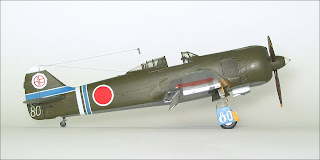The second Takara issue Ki-21 'Sally' built by Gonzalo Guzmán is the Ki-21-II Otsu variant provided for in the kit, representing an aircraft of the 3rd Dokuritsu Hikotai (Independent Flying Unit - sometimes incorrectly referred to as Chutai) prior to its participation in the Giretsu (義烈 - Heroism) commando raid against Yontan airfield on Okinawa.
Operation Gi, the Giretsu attack on Yontan, is well known and has been widely documented elsewhere so the details, although some are contradictory or obscure, will not be repeated here. One of the best accounts may be found in the Arawasi Eagle Series No.3 on the Mitsubishi Ki-21 'Sally' and Fiat BR.20 'Cicogna' (undated) which is highly recommended.
According to the Arawasi book the personnel for the 3rd DH were drawn from the Hokota Instructional Air Division for medium and light bombers, expecting to be operating the Ki-46. According to Minoru Akimoto the unit was established at Hamamatsu in October 1944, which seems logical given their intended operation of the Ki-21. The unit was one of three established for the purpose of raiding US airfields in the Marianas, the others being 2nd DH and 4th DH. The unit's tail insignia represents the character for '3' - San 三.

Gonzalo's model depicts a 3rd DH aircraft prior to modifications as a transport aircraft for Operation Gi, intended to be force landed at Yontan with a complement of suicide commandos, and with all armament removed including the dorsal turret. Although often depicted with dark green mottle over natural metal after carefully studying photographs Gonzalo elected to apply the mottle over a grey base coat. The subject of Army mottles will be further explored here in a future blog article.


With special thanks to Gonzalo for sharing these images of his excellent 'Sally' model, testimony to both the quality of the near 50 year old Revell-Takara kit and his modelling skills in bringing it to such impressive life.

Image credit: All photos © 2023 Gonzalo Guzmán

















































